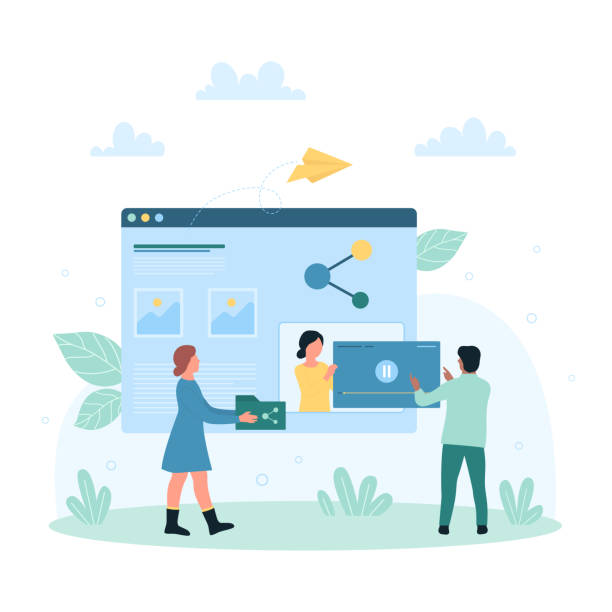1. Introduction to the Importance of SEO-Optimized Website Design

In today’s digital world, merely having a website is not enough.
To be seen among a plethora of competitors, your website must be optimized for search engines like Google.
This is where the concept of SEO (Search Engine Optimization) and the importance of SEO-optimized website design become prominent. An optimized site not only provides a better user experience but also significantly increases your chances of ranking high in search results.
Imagine you have a product or service that your potential customers are searching for; if your site isn’t on the first page of Google, you will practically lose many opportunities.
#Website_design, #Persian_SEO, and #site_optimization are among the key terms widely used in this field.
The main goal of #SEO-oriented_website_design is to increase organic traffic and attract target audiences who are directly looking for your products or services.
This approach helps you maximize your online investment and achieve greater profitability.
This chapter, in an explanatory and educational manner, helps you gain a better understanding of this vital concept and realize why this type of design is essential for the survival and growth of your business.
This is not just an option, but a necessity.
Disappointed with your online store’s low conversion rate? Rasaweb transforms your online store into a powerful tool for attracting and converting customers!
✅ Significant increase in visitor-to-buyer conversion rate
✅ Unparalleled user experience to boost customer satisfaction and loyalty⚡ Get free consultation from Rasaweb!
2. Key Principles of On-Page SEO in Web Design

After understanding the general importance, it’s time to delve into the technical details of SEO-optimized website design.
On-Page SEO refers to all optimizations you can directly perform on your website to achieve a better ranking in search engines.
This includes optimizing page titles (Title Tags), meta descriptions, correct use of Heading tags (H1-H6), and a friendly URL structure.
Every page of your site should have a unique and engaging title that includes its main keyword.
Meta descriptions, though not directly affecting ranking, play an important role in encouraging users to click on your link in search results.
Using Heading tags is essential for structuring content and improving readability, as it helps search engines understand the structure and importance of different sections of the text.
Furthermore, optimizing images with appropriate Alt Text and compressing them to increase loading speed are other important on-page SEO tips.
This section, in a specialized and guiding manner, helps you take practical steps to improve your site’s on-page SEO and build a strong foundation for a search engine optimized website.
Don’t forget that every piece of your content should be created carefully and purposefully.
3. Technical SEO and Website Loading Speed

Technical SEO is another vital part of SEO-optimized website design that focuses on improving the technical aspects of the website for better crawling and indexing by search engines.
One of the most important factors in this section is website loading speed.
Google has announced that site speed is a ranking factor, and users also attach great importance to website responsiveness.
Using Content Delivery Networks (CDN), compressing images and files, and using browser caching can significantly increase your site’s speed.
Concepts like Core Web Vitals, which include metrics such as Largest Contentful Paint (LCP) and Cumulative Layout Shift (CLS), are now highly important.
In addition to speed, website security (HTTPS), structured data (Schema Markup), and having a correct robots.txt file and XML Sitemap are other key aspects of technical SEO that help search engines understand and crawl your site more efficiently.
This specialized and analytical section teaches you how to prepare your site’s technical infrastructure for the best SEO performance.
| Factor | Explanation | Importance in SEO |
|---|---|---|
| Image Compression | Reducing image file size without significant loss of quality | Reduces page loading time, improves Core Web Vitals |
| Using CDN | Distributing content from servers closer to the user | Reduces network latency, increases global site speed |
| Browser Caching | Storing static files in the user’s browser | Faster loading for subsequent visits |
| Minifying Code | Removing whitespace, comments, and unnecessary code from CSS and JS | Reduces file size, accelerates parsing and execution time |
4. Content Strategy for SEO Success

Content is king; this phrase never loses its importance in the world of SEO.
For an SEO-optimized website design to achieve desired results, it requires a strong and targeted content strategy.
Your content should not only be valuable for search engines but, more importantly, for users.
This means producing high-quality, unique, relevant, and comprehensive content that answers user questions and addresses their needs.
Keyword research is the cornerstone of any successful content strategy.
You need to know what phrases your target audience is looking for and then build your content around those keywords.
But merely using keywords is not enough; the concept of “User Intent” is of high importance.
Is the user looking for information, intending to buy, or looking for directions? Your content must align with this intent.
Using Content Clusters, which are collections of related pages around a main topic, can help you establish authority and expertise in your field.
This content approach not only helps improve your ranking in search results but also increases user time on site and reduces bounce rate.
This section, in an educational and with thought-provoking content, helps you devise an effective content strategy for your search engine optimized website design.
Is your current online store design losing customers and sales?
Rasaweb is your solution with modern and user-friendly online store designs!
✅ Significant increase in conversion rates and sales
✅ Strong branding and building customer trust
⚡ Get a free online store design consultation from Rasaweb!
5. The Relationship between User Experience (UX) and SEO
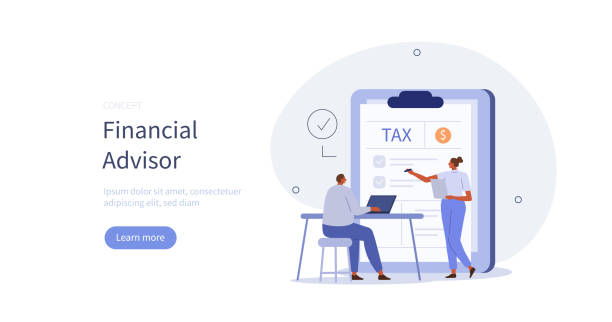
Today, the line between User Experience (UX) and SEO is increasingly blurring.
Google increasingly prioritizes user experience signals, as its ultimate goal is to provide the best results to users.
An SEO-optimized website design must provide a seamless user experience.
A website that is difficult to navigate, whose pages do not load well, or whose content is disorganized, even if strong in terms of on-page and technical SEO, will ultimately not achieve a good ranking.
Factors such as a low Bounce Rate, longer Dwell Time on the site, and a high conversion rate all send positive signals to search engines, indicating user satisfaction with your content.
Visually appealing design, intuitive navigation (Visual Navigation), clear Calls to Action (CTAs), and a logical information structure all contribute to improving UX.
Mobile optimization, which we will cover in the next chapter, is also an integral part of UX.
Websites designed with the end-user in mind will naturally perform better in SEO because search engines have adjusted their algorithms to identify and reward such websites.
This analytical and explanatory section helps you understand this symbiosis between UX and SEO.
6. Mobile-First Indexing and Responsive Design
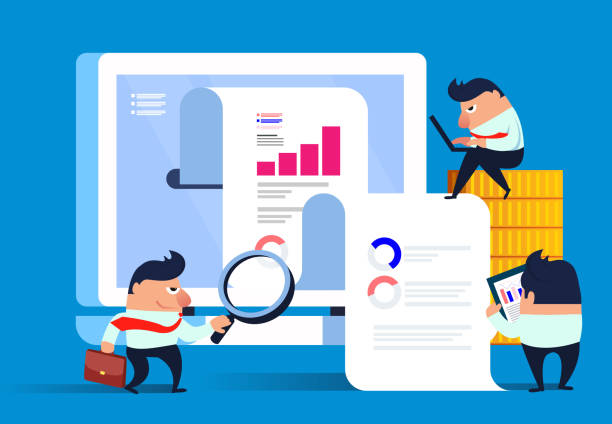
In recent years, Google has officially announced its shift to mobile-first indexing.
This means that for ranking websites, Google first examines and crawls your site’s mobile version and then makes decisions based on it.
If your website is not optimized for mobile devices, even if its desktop version is perfect, you may lose your rankings in search results.
This highlights the importance of Responsive Design more than ever.
A responsive design ensures that your website automatically adapts to the screen size of the user’s device, from desktop computers to tablets and smartphones, providing a seamless user experience.
This not only helps improve SEO but also facilitates user access to your content on any device.
SEO-optimized website design in the current era would be incomplete without responsiveness.
Ensure that all elements of your site, including images, forms, and buttons, are displayed correctly and are easy to use on mobile devices.
This newsworthy and specialized section reflects Google’s current approach and provides you with the necessary guidance to ensure mobile optimization in your search engine optimized website design.
This is a fundamental step to stay competitive and attract more audiences.
7. Link Building and Off-Page SEO

While on-page and technical SEO relate to your control over website content and infrastructure, Off-Page SEO focuses on activities performed outside your website that help improve its authority and ranking.
The most important element of off-page SEO is Link Building.
Backlinks, or links pointing to your site from other reputable websites, are considered votes of confidence by search engines.
The more numerous and higher quality your backlinks, the higher your Domain Authority will be, and the greater your chance of ranking for desired keywords.
But quantity alone is not important; link quality is more significant.
Getting links from spammy or irrelevant sites can harm your ranking.
Effective link-building strategies include producing valuable content that naturally attracts links, proper internal linking (connecting different pages of your site to each other), and social media engagement.
Also, active presence on social media and sharing your content there, though not a direct ranking factor, can help increase visibility, attract traffic, and ultimately increase the chances of receiving natural backlinks.
This section, in an educational and specialized manner, teaches you how to increase your online authority and ensure that your SEO-optimized website design is also externally strengthened.
| Link Type | Explanation | Impact on SEO |
|---|---|---|
| Backlink | A link from another site to your site | Increases domain authority, improves ranking (if from a reputable site) |
| Internal Link | A link from one page of your site to another page on the same site | Facilitates crawling, distributes page authority, improves user experience |
| External Link | A link from your site to another site | Increases content credibility, signals to Google for topical relevance |
| Dofollow Link | Default links that pass SEO authority | Transfers “link juice” and authority to the destination page |
| Nofollow Link | Links that tell search engines not to pass SEO authority | Does not directly transfer authority, but may attract traffic |
8. Security (HTTPS) and Its Role in SEO
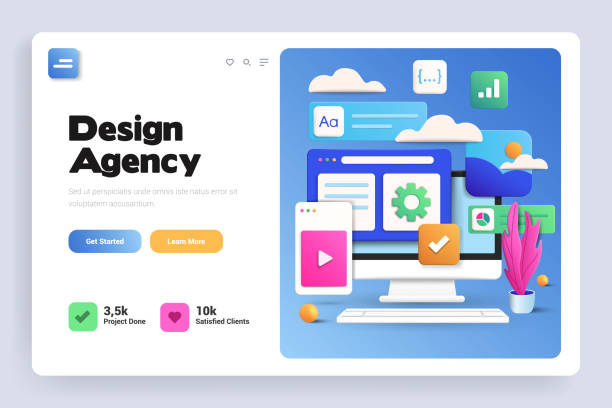
Website security is no longer a luxury option, but an absolute necessity and an integral part of any SEO-optimized website design.
Since 2014, Google has officially announced that HTTPS acts as a ranking factor.
This means that websites using the secure HTTPS protocol will have a slight advantage in search results compared to HTTP websites.
HTTPS, using an SSL/TLS certificate, establishes an encrypted connection between the user’s browser and the website server, protecting sensitive information such as passwords, credit card details, and personal data.
This is not only important for SEO but also increases user trust in your site.
Today’s users pay attention to security indicators like the green lock in the browser’s address bar and avoid entering information on insecure sites.
Migrating from HTTP to HTTPS is a technical process that needs to be done carefully to prevent SEO issues such as loss of ranking or indexing problems.
This explanatory and specialized section helps you understand the importance of your website’s security and proceed with implementing HTTPS in your SEO-oriented website design.
This is an essential investment for the future of your online business.
Tired of losing customers due to poor online store design? With Rasaweb, solve this problem forever!
✅ Increase sales and conversion rate from visitor to customer
✅ Smooth and engaging user experience for your customers⚡ Get free consultation
9. Continuous Analysis and Optimization
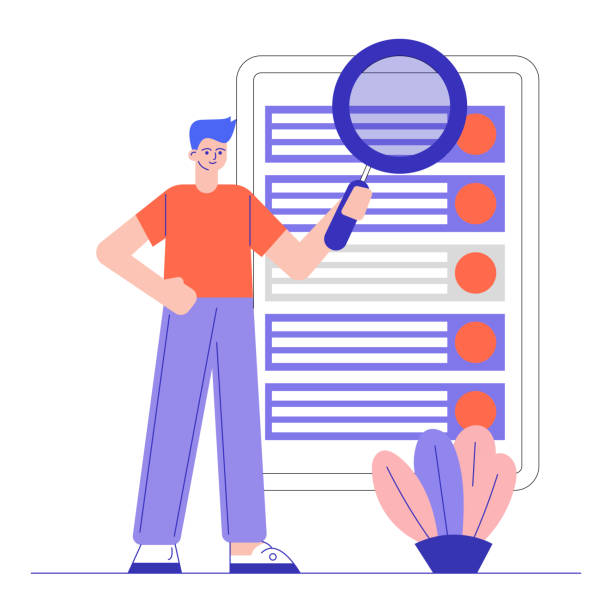
SEO is not a one-time process, but a continuous journey that requires constant monitoring, analysis, and optimization.
Even after completing all steps of SEO-optimized website design, your work is not finished.
The world of SEO is dynamic; Google’s algorithms are constantly changing, and competitors are not idle.
To maintain and improve your rankings, you must regularly monitor your site’s performance.
Tools like Google Analytics and Google Search Console provide valuable data.
You can see how users interact with your site, which pages get more visits, what your bounce rate is, and for which keywords your site ranks.
This data helps you identify your site’s strengths and weaknesses and make data-driven decisions to improve performance.
A/B testing for Conversion Rate Optimization (CRO) and examining small changes in design or content can yield significant results.
This analytical and iterative approach allows you to adapt to market and algorithm changes and ensure that your search engine optimized website always remains at its peak performance.
This guiding and analytical section highlights the importance of continuous monitoring.
10. The Future of SEO and Web Design

The world of SEO and web design is constantly evolving, and predicting its future is exciting yet challenging.
SEO-optimized website design in the future will be increasingly intertwined with Artificial Intelligence (AI), Voice Search, and Visual Search.
Google’s algorithms are becoming smarter and can understand user intent with greater accuracy.
This means your content should not only include keywords but also be comprehensively topical and answer more complex questions.
Optimizing for voice search requires focusing on longer, conversational keywords that people use in everyday speech.
Also, with the expansion of visual tools like Google Lens, optimizing images and using appropriate Alt Text will become even more important.
Video marketing and optimizing videos for search engines are also growing trends.
The main challenge for businesses is how to keep pace with these changes and adapt their strategies for building an SEO-oriented site in the future.
Readiness for change and flexibility are the keys to long-term success in this field.
This entertaining and analytical section gives you an overview of future SEO trends and prepares you for the upcoming challenges in SEO-optimized website design.
This exciting future brings countless opportunities for innovation and growth.
Frequently Asked Questions
| No. | Question | Answer |
|---|---|---|
| 1 | What is an SEO-optimized website? | A website designed and developed in compliance with Search Engine Optimization (SEO) principles to achieve a higher ranking in search results. |
| 2 | Why is having an SEO-optimized website important? | It increases visibility, attracts organic traffic, boosts conversions, and builds brand credibility, all of which contribute to business growth. |
| 3 | What are the key elements of SEO-optimized website design? | Technical SEO (speed, mobile compatibility), On-Page SEO (keywords, content), User Experience (UX), and website security (HTTPS). |
| 4 | How does website speed affect SEO? | Faster sites improve user experience, reduce bounce rate, and are favored by search engines, leading to better rankings. |
| 5 | Is mobile compatibility important for SEO? | Absolutely. Google uses mobile-first indexing, so responsive design for mobile is crucial for ranking. |
| 6 | What role does content play in SEO-optimized website design? | High-quality, relevant, and keyword-optimized content is essential for attracting users and signaling relevance to search engines. |
| 7 | What is keyword research and why is it important? | Finding popular search terms people use. This process helps align content with user intent and attracts relevant traffic. |
| 8 | How is User Experience (UX) related to SEO? | Good UX (easy navigation, readability) keeps users on the site longer, reduces bounce rate, and sends positive signals to search engines. |
| 9 | What is a Sitemap and how does it help SEO? | It’s a file that lists all pages of a site. It helps search engines crawl and index your site more effectively. |
| 10 | Should I use HTTPS for my website? | Yes, HTTPS provides security and is considered a small ranking factor. It also increases user trust. |
And other services of Rasaweb Advertising Agency in the field of advertising
Smart Sales Automation: An effective tool to increase sales with the help of Google Ads management.
Smart Digital Branding: A fast and efficient solution for increasing sales with a focus on intelligent data analysis.
Smart Social Media: A combination of creativity and technology to increase click-through rates by precise audience targeting.
Smart Brand Identity: A combination of creativity and technology to increase sales through attractive user interface design.
Smart Website Development: A combination of creativity and technology for campaign management through SEO-driven content strategy.
And over hundreds of other services in the field of internet advertising, advertising consultation, and organizational solutions
Internet Advertising | Advertising Strategy | Advertorial
Sources
SEO-Optimized Website Design Website Design with an SEO Perspective WordPress SEO Tutorial Specialized Website Design
?With Rasaweb Afarin, elevate your business in the digital world! By providing comprehensive digital marketing agency services including responsive website design, SEO, and content creation, we pave the way for your online success.
📍 Tehran, Mirdamad Street, next to Bank Markazi, Kazeroon Jonubi Alley, Ramin Alley, No. 6

